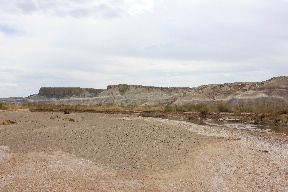Resource 1: Geology
Rationale
Rivers act as sampling mechanisms across large area, studying their sediments provides both average and speci?c geological and geochemical information for much larger areas than can be otherwise obtained for a single site. The Mars Path?nder targeted in the outwash area of Ares Vallis because the deposits were expected to contain a range of rocks from further upstream. The rocks were examined by the Path?nder camera and the camera and APX onboard the Sojourner rover. A diversity of rocks was observed, consistent with ?uvial transport and mixing, con?rmed by the evidence of boulder imbrication.
On Earth mineral explorers and environmental scientists use stream sediment sampling (focusing on sediment mineralogy and chemistry) to look for mineral deposits or sources of contamination upstream.
One single sample can characterise an entire subcatchment.
Outcomes:
- Understanding on how rivers collect sediments across their catchments and export them.
- Works on Earth and Mars - universality of physical processes.
- Application theoretical (Mars and applied (mineral exploration, environmental geology) science
- Collection and analysis of ?eld data.
- Rock and mineral identi?cation.
- How to read geology maps.
- How human factors can effect science.
Experiment
Utah
Location 1

Cow Dung Road Cattle Grid
(just off the main road).
The ridge surface is composed of rounded pebbles of a residual alluvial terrace.
- Mark a point with a GPS and collect 100 pebbles (golf ball sized and larger).
- Sort into rock types – how many rock types are present?
- Classify pure mineral fragments and rock types – minimum into igneous/sedimentary, preferably igneous/sedimentary/metamorphic. Older students might be able to further classify each type - igneous(volcanic/ plutonic/prophyry) / sedimentary (sandstone/siltstone/mudstone/greywacke/limestone/chert/ conglomerate) / metamorphic (hornfels/quartzite/slate/schist/gneiss)
Q1 – what does this tell us about the geology of the source area?
Q2 – can we locate the source areas on a geology map?
Location 2

Muddy Creek
Modern gravel. Repeat experiment at Location 2 |
Additional question: Is there any difference in the composition of the modern and ancient gravels?
Look for fossils (there should be!)
Human factors exercise:
How much slower is sampling in a suit compared to sampling without one?
New Zealand
Students can repeat the exercise with any nearby gravelly river that is probably at least 10 km long. |
- They will need a geology map and materials to help them identify rocks and minerals.
- They can compare their results with MDRS and with students from other parts of NZ.
- They can carry out human factors comparison using a full-face motor cycle helmet, overalls, loaded hiking back pack and ski gloves to present a space suit.
Resource prepared by
Dr Jonathan Clarke
Mars Society Australia
Mars Analog Field Test/ Resource Kit
Purpose
In KiwiSpace Mars analogue simulations, crew members spend two weeks living and working as though on Mars at the Mars Society’s Mars desert research Station (MDRS) deep in the Utah desert.
The station is an analogy for what an early mission to Mars habitat might be like.
It comprises a ten-metre diameter two-storey “habitat” in which international crews live and work over a twoweek period, or “mission”. There is also a greenhouse, and an observatory.
Obviously Utah gravity is Earth gravity (Mars has only one-third Earth’s pull), and the atmosphere is breathable, as opposed to the approximately-95% carbon dioxide Martian atmosphere but the crews nevertheless live the life of Martian explorers to the full. Crew members wear functioning simulated spacesuits while outside the habitat (called the “hab” for short), and communicate via radio. Each mission undertakes work programmes in areas such as geology, biology, nutrition, astronomy, etc., and crew members are expected to help with all tasks involving keeping the hab going. Occasionally this requires a bit of engineering.
Following an initial training and induction period, the crew will perform a range of experiments and exercises, related to their areas of expertise or interest.
Schools and other groups within New Zealand will be able to propose and contribute additional experiments.We will also be encouraging schools to run ‘control’ versions of experiments back in New Zealand for comparison, and to increase engagement. |